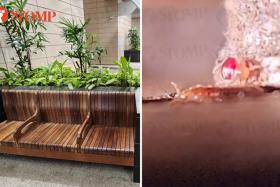Six of Singapore’s 71 national monuments are on Telok Ayer Street
Six of our 71 national monuments are in Telok Ayer Street
With the addition of the Fullerton Building on Dec 8,the number of national monuments here is now 71.
If a site or structure is gazetted as a national monument, it means it holds historical, architectural and social importance to Singapore's heritage.
But did you know that six of these 71 monuments are actually on the same street?
Telok Ayer Street is home to the Ying Fo Fui Kun building, the Nagore Dargah Indian Muslim Heritage Centre (formerly the Nagore Dargah shrine), the Singapore Yu Huang Gong temple (formerly the Keng Teck Whay building), the Thian Hock Keng temple, the Al-Abrar Mosque and the Telok Ayer Chinese Methodist Church.
Telok Ayer means water bay in Malay. The area was once a coastal road that was a landing point for pioneer immigrants who docked their boats and sampans there.
Grateful for their safe journeys to Singapore, many immigrants built places of worship around Telok Ayer Street to thank their gods.

1 NAGORE DARGAH INDIAN MUSLIM HERITAGE CENTRE
WHAT: It was built between 1828 and 1830 by the Chulia community.
WHY: It was originally a shrine and was built to thank a South Indian holy man named Shahul Hameed, as the community believed that their safe journey to Singapore was due to his blessing.
WHAT'S UNIQUE: It is now a heritage centre for the Indian Muslim community, featuring exhibits and artefacts.

2 AL-ABRAR MOSQUE
WHAT: The mosque began as a thatched hut in 1827 and was completed in 1855. It is one of the oldest mosques in Singapore.
WHY: Although it was built as a place of worship, it was also a place for the Indian Muslim community to socialise.
WHAT'S UNIQUE: Although the mosque is situated in a row of shophouses, it is distinguishable by two octagonal minarets, which are adorned with a crescent moon and a star.

3 SINGAPORE YU HUANG GONG TEMPLE
WHAT: Built before 1856, this was once the clan building of the Keng Teck Association. It is now a Taoist temple.
WHY: It was set up by Straits Chinese businessmen as a clan complex for members to worship Yu Huang Da Di (Jade Emperor), Sanguan Dadi (Three Emperor-Officials) and member families' ancestral tablets.
WHAT'S UNIQUE: The building's most striking feature is its octagonal pagoda. On each roof ridge is an upturned "swallow tail".

4 TELOK AYER CHINESE METHODIST CHURCH
WHAT: Originally known as the Chinese Methodist Church, it was built in 1925, after moving from Boon Tat Street in 1913 and from the former Upper Nankin Street in 1889.
WHY: It was set up as the first place of worship for Chinese Methodist Christians, who were mainly Hokkien-speaking.
WHAT'S UNIQUE: The architecture is a fusion of European and Chinese styles. Its overall design follows a Western style, with many arches, but the roof is designed in a Chinese style.

5 YING FO FUI KUN BUILDING
WHAT: This Hakka clan house and temple building was built in 1844.
WHY: The main hall has an altar to Guan Sheng Di Jun (God of War) for members to remember the loyalty and camaraderie of the Hakka community.
WHAT'S UNIQUE: The exterior windows were placed higher than an average man's height to prevent intruders from entering the building. This was inspired by Hakka "tu lou" (walled village) houses in China.
6 THIAN HOCK KENG TEMPLE
WHAT: The site originally had a makeshift temple. But as the number of Chinese immigrants grew, the temple was replaced with its present permanent structure. Construction started in 1839 and ended in 1842.
WHY: It was built by the very first Chinese immigrants to thank Mazu, the Taoist goddess of the sea, for their safe trip.
WHAT'S UNIQUE: Within the Thian Hock Keng temple is a pagoda known as Chongwen Ge, which is jointly gazetted together with the temple as a national monument. The pagoda mirrors the pagoda at the former Keng Teck Whay building, creating symmetry between both monuments.

Get The New Paper on your phone with the free TNP app. Download from the Apple App Store or Google Play Store now


